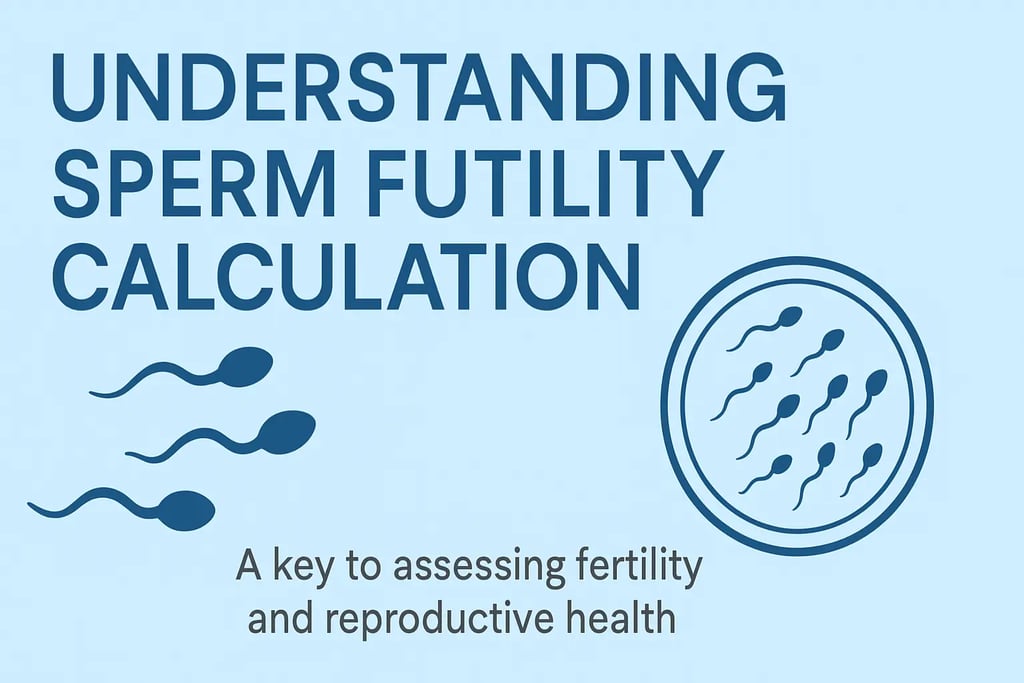Understanding Sperm Futility Calculation: Key to Assessing Male Fertility and Reproductive Health
Learn what sperm futility calculation is and how it helps assess sperm quality, motility, and morphology. Discover the key factors affecting male fertility and effective ways to improve reproductive health.


Understanding Sperm Futility Calculation: A Key to Assessing Fertility and Reproductive Health
Introduction to Sperm Futility Calculation
Sperm futility calculation plays a vital role in evaluating male reproductive health and diagnosing infertility issues. This scientific assessment helps doctors determine sperm viability, motility, and morphology—three essential parameters for successful fertilization. For couples facing challenges in conception, understanding sperm quality provides valuable insights into potential reproductive faults that may hinder fertility.
The process involves analyzing several key sperm parameters:
Sperm Count: Measures the concentration of sperm in a semen sample.
Sperm Motility: Determines the percentage of sperm that are actively moving and capable of reaching the egg.
Sperm Morphology: Evaluates the shape and structure of sperm cells, which influence their fertilization potential.
Together, these metrics form the foundation of male fertility testing, helping clinicians assess sperm functionality and compatibility with the reproductive process.
Beyond mere numbers, the sperm futility test carries significant implications for fertility treatments. Abnormal sperm results may prompt doctors to recommend specialized interventions or assisted reproductive technologies (ART) such as in vitro fertilization (IVF) or intracytoplasmic sperm injection (ICSI). Therefore, accurate sperm analysis is essential for both diagnosis and developing tailored fertility treatment plans aimed at improving conception outcomes.
By thoroughly analyzing sperm health, medical professionals can identify underlying reproductive issues and suggest effective measures to enhance fertility. Thus, understanding sperm futility is an integral part of navigating the complex journey toward parenthood.
Factors That Affect Sperm Quality
Sperm quality depends on a wide range of biological and environmental factors that influence sperm production, motility, and overall health. Recognizing these factors is the first step toward improving male fertility.
1. Biological Factors
Genetics: Hereditary conditions such as Y chromosome microdeletions can result in low sperm count or male infertility.
Age: Men over 40 often experience reduced testosterone levels, leading to lower sperm motility and function.
Hormonal Imbalance: Testosterone and other hormones are crucial for sperm development. Conditions causing low testosterone or hormonal disruptions can impair sperm production.
2. Environmental and Lifestyle Factors
Lifestyle choices and surroundings significantly influence sperm health:
Diet and Nutrition: A balanced diet rich in antioxidants, zinc, and vitamins C & E supports sperm motility and vitality.
Smoking and Alcohol: Both reduce sperm count and affect morphology.
Toxins and Chemicals: Exposure to heavy metals, pesticides, or endocrine disruptors can damage sperm DNA.
Obesity and Chronic Illness: These can disrupt hormone levels and blood flow, reducing fertility potential.
Maintaining a healthy lifestyle, minimizing exposure to toxins, and addressing medical conditions early can drastically improve sperm quality and reproductive outcomes.
Evaluating Female Factors in Reproductive Health
While male infertility accounts for about 40–50% of cases, female factors also play a significant role in conception challenges. A complete fertility assessment involves evaluating both partners.
Common Female Fertility Factors Include:
Ovulation Disorders: Conditions such as polycystic ovary syndrome (PCOS), premature ovarian insufficiency, and hypothalamic amenorrhea can disrupt ovulation.
Fallopian Tube Blockages: Caused by pelvic inflammatory disease (PID), endometriosis, or previous surgeries, these blockages prevent sperm from reaching the egg.
Uterine Abnormalities: Fibroids, polyps, or structural malformations can affect implantation and early pregnancy.
Hormonal Imbalances: Proper hormone levels are necessary to regulate menstrual cycles and support pregnancy.
External factors such as age, stress, and lifestyle choices further affect female fertility. Therefore, an integrated evaluation of both male and female partners ensures a more accurate diagnosis and effective treatment strategy.
Identifying the Source of Fertility Issues
Identifying the root cause of infertility is critical for formulating successful treatment plans. Fertility assessments typically begin with diagnostic tests for both men and women.
For Men: Semen Analysis
A semen analysis evaluates:
Sperm Count (concentration)
Motility (movement)
Morphology (shape)
Abnormalities in these areas may indicate male factor infertility, requiring further evaluation through hormonal tests or advanced sperm function analysis.
For Women: Hormonal and Imaging Tests
Women undergo hormonal evaluations to measure:
Luteinizing Hormone (LH)
Follicle-Stimulating Hormone (FSH)
Estradiol and other reproductive hormones.
Ultrasound and imaging tests help identify PCOS, uterine abnormalities, or other reproductive disorders.
Advanced Diagnostic Techniques
Modern reproductive science employs genetic testing, laparoscopy, and advanced sperm function tests to detect hidden fertility issues. These techniques allow healthcare providers to design personalized fertility treatment plans tailored to each couple’s needs.
Conclusion
Sperm futility calculation is an essential part of infertility diagnosis and fertility management. By analyzing sperm count, motility, and morphology alongside female reproductive factors, healthcare experts can pinpoint underlying causes and suggest effective solutions. Whether through lifestyle modifications, medical treatments, or assisted reproductive technologies, understanding sperm and reproductive health offers couples the best chance at achieving successful conception.
